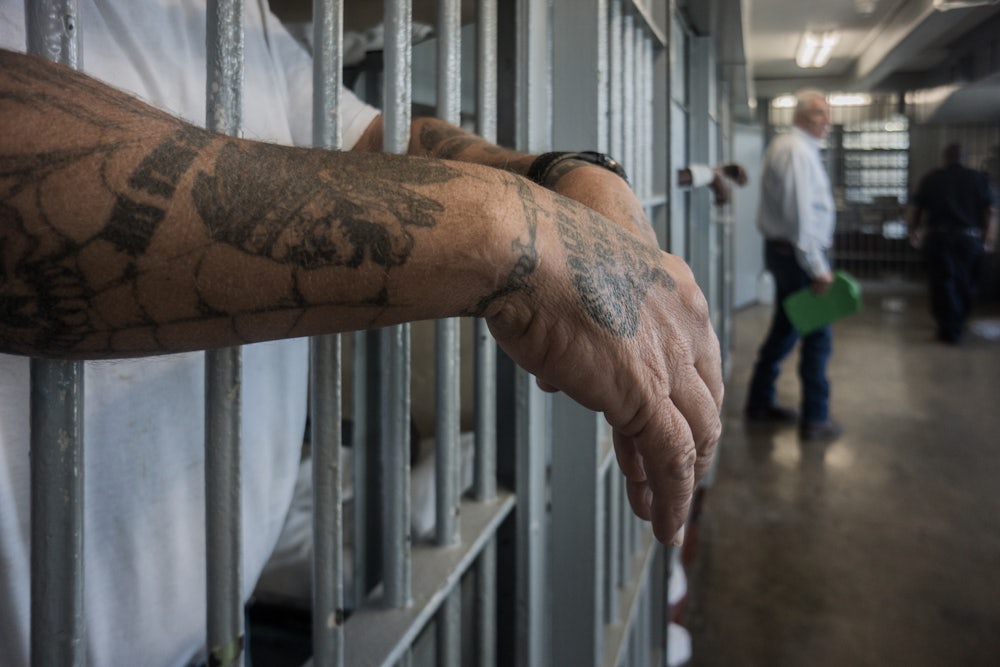On January 20, President Trump signed the executive order “Protecting the American People Against Invasion”—ostensibly the first step in what he promised would be the largest mass deportation operation in U.S. history. Sweeping measures have quickly followed: sealing the border, canceling asylum appointments, attempting to end birthright citizenship, and revoking Biden-era humanitarian parole programs.
In the months before Trump’s inauguration, experts warned that his anti-immigrant policies would have severe consequences, particularly for the U.S. food system. Nearly 70 percent of farmworkers in the United States are born outside the country, and more than 40 percent are undocumented. The fear of ICE raids, detention, and deportation has already had a chilling effect on immigrant farmworkers, and the situation is likely to worsen.
But the problem of labor shortages in agriculture is not new, and whenever the demand for cheap, disposable labor has outstripped available workers, the U.S. has historically turned to another vulnerable group: incarcerated people. Over a century ago, the practice of convict leasing arose as a way to fill labor gaps by using incarcerated Black men as free labor for agricultural and industrial work. It eventually evolved into the system of prison farms, where prisoners—often poor and disproportionately Black—were put to work growing food for both the prison system and, at times, private interests.
With mass deportations threatening to strip the agricultural workforce, it’s not impossible to imagine that states could once again tap incarcerated workers to fill the gap. This shift, however, may not lead to the economic benefits that Trump and his allies have promised. In reality, agriculture has long depended on the labor of the most economically and racially marginalized segments of the population to keep costs low, and any sudden disruption could send shock waves through the system.
Stephen Miller, now White House deputy chief of staff, predicted in 2023, “Mass deportation will be a labor-market disruption celebrated by American workers, who will now be offered higher wages with better benefits to fill these jobs.” But wages are unlikely to rise, particularly in an industry that often operates on narrow margins. Instead, the focus may turn back to prisons, where cheap labor has historically been a solution to agricultural worker shortages.
“The earliest iterations of prisons in this country included something called convict leasing, where prisons would actually loan out the labor of incarcerated people to farms,” says New Republic contributor Wanda Bertram of the Prison Policy Initiative, a criminal justice reform nonprofit.
The Thirteenth Amendment, which abolished slavery except for those convicted of a crime, created a legal loophole that fueled the convict leasing system in the South during Reconstruction. This system exploited the labor of incarcerated people—primarily Black men, often imprisoned on vague charges like vagrancy through racist laws known as Black Codes—and forced them to work on farms, railroads, and in coal mines, driving the region’s economy through cheap, forced labor.
Bertram notes that the notion that prisons could serve as a self-sustaining economic engine, providing cheap labor for agricultural work, evolved into the system of prison farms that still exists today. The shift from forced labor to more structured work-release programs in the twentieth century laid the groundwork for the contemporary reliance on incarcerated people to fill labor shortages, not just in prisons but in industries like agriculture and food processing.
Although convict leasing was formally outlawed in many states by the early twentieth century, the need for cheap agricultural labor did not disappear. Instead, the exploitation of incarcerated people adapted to new legal and economic realities. During World War II, faced with a massive shortage of agricultural workers who had been called into military service, the United States implemented the largest guest worker program in its history. The Bracero Program brought five million farm and railroad workers into the country from Mexico—a precursor to today’s H2A visa program. At the same time, many of the 400,000 German and Italian POWs held in camps on U.S. soil were also made to work as farm laborers, picking lemons, potatoes, and cotton in California, Idaho, and Texas, among other states.
While the Bracero Program brought millions of Mexican workers into the U.S. to fill agricultural labor shortages during World War II, it continued a legacy of racialized and exploitative labor practices. The program modernized and formalized the idea of agricultural workers as a disposable, undervalued workforce—building on the centuries-old reliance on cheap, often coerced labor from marginalized groups.
With the prospect of mass deportations stripping the food industry of its primary workforce, states may soon find themselves looking for alternative sources of labor. Could the Trump administration’s crackdown on immigration ultimately lead to incarcerated people being deployed as farm and food-processing workers on a larger scale?
“The short answer is yes,” says Joshua Sbicca, a professor of sociology and director of Colorado State University’s Prison Agriculture Lab. “The reason that I think that is because we already have historical evidence that that’s happened.”
Even a 10 or 20 percent reduction in the agricultural workforce would put enormous pressure on growers to meet their production goals. “So they’re going to look to other places to try to solve that problem,” Sbicca says, adding that incarcerated people are “a population who, for a long time, have served as a reserve army of labor when it serves the interest of the state or various private interests.”
Indeed, in 2007, a year after Colorado’s legislature passed a raft of immigration laws that severely restricted the rights of undocumented immigrants and punished employers who hired them, the state’s Department of Corrections implemented a pilot program in which incarcerated people who were deemed a low security risk were contracted to pick fruits and vegetables on more than a dozen private farms. Farms paid wages of $9.60 per hour per incarcerated worker, though the workers themselves received less than half of that wage after Department of Corrections deductions—a standard practice for work-release programs.
Although anti-immigrant legislation is typically advanced by Republicans, the use of incarcerated workers enjoys bipartisan support. In 2011, facing a shortage of seasonal workers who feared being detained due to their immigration status, Democratic Governor Chris Gregoire conceded that it was necessary to bring incarcerated workers into Washington state’s orchards “or let the apples rot.” In 2014, Republican Idaho Governor C.L. “Butch” Otter followed suit, signing into law a program that allowed people incarcerated at state prisons to work on private farms during the crucial growing and harvest seasons.
But there’s a vastly underappreciated fact that these moves leave unaddressed: Agriculture requires highly skilled labor and experience. “It turns out that incarcerated people can’t just be slotted into agricultural work, because they’re not skilled,” Sbicca says. When Georgia experienced an exodus of undocumented workers following the enactment of an anti-immigration law, House Bill 87, considered one of the toughest such laws in the nation at the time, the state turned to prison labor to fill the gap—but the strategy spectacularly backfired when incarcerated workers walked off the job due to heat and exhaustion. A study by the University of Georgia later revealed that in the wake of H.B. 87’s passing, the state suffered $140 million in crop losses due to a shortage of over 5,000 farmworkers.
At the same time, agricultural work-release programs can place untrained incarcerated workers in hazardous environments. “All you need to do is look at occupational health statistics and agriculture to understand that agriculture is one of the most dangerous occupations that exists in the U.S., period,” Sbicca says. “Are we essentially signaling to incarcerated people that they only deserve to be in these most dangerous occupations?”
Food-processing jobs aren’t necessarily safer, either. Hickman’s Family Farm, the largest egg producer in the Southwest, has long employed incarcerated workers through the Arizona Department of Corrections, Rehabilitation, and Reentry, sometimes under allegedly dangerous conditions. “There are cases of injury with that particular company,” Sbicca notes, “but there’s cases of incarcerated folks being leased out to Tyson, which has notorious labor abuses, and poor workplace conditions.”
A bombshell report by the Associated Press in 2024 unveiled a complex web linking prison labor to private food corporations, among them Tyson Foods—which owns Hillshire Farms, Jimmy Dean, and Aidells—and a chicken processor tied to Cargill, the largest private company in the U.S. The exact number of incarcerated individuals working in poultry processing is difficult to determine, but an investigation by the Marshall Project counted 24 incidents of incarcerated workers being injured at poultry plants in Georgia and North Carolina between 2015 and 2018. Poultry-processing work can also prove fatal: In 2017, 33-year-old Frank Dwayne Ellington, who had served nearly eight years of a life sentence for robbery, was working at a poultry plant in rural Alabama when he was pulled into a carcass rehanger and killed instantly.
“This new reliance, or attempt to rely, on incarcerated labor is sort of a deepening of patterns that we’ve seen in other points in time,” says Carrie Freshour, a professor of geosciences at Georgia State University who studies the connections between race, incarceration, and low-wage food and agricultural labor in the South, particularly in poultry processing.
Freshour’s research has found that in Georgia’s poultry industry, the labor shortage argument has repeatedly been used as a pretext to disrupt organized labor. “In each moment of history that I’ve looked at where there’s been a major reorganization of who’s working in the poultry industry, it’s come as a response to labor organizing,” she says.
“I think that we’re seeing another sort of ramping up of the labor shortage argument that justifies this anti-immigration legislation and direct assault on undocumented peoples,” Freshour adds, “while at the same time not holding these companies accountable for any sort of just labor practices.”
Freshour highlights the connection that some scholars have drawn between the “Day Without Immigrants” protests and the wave of strict anti-immigrant legislation that followed in subsequent years. Millions of immigrants and their allies participated in the May Day events in 2006—one of the largest single-day demonstrations in U.S. history—in response to the proposed Sensenbrenner Bill (H.R. 4437), which sought to criminalize undocumented immigrants and those aiding them.
Republican lawmakers, seeing the growing visibility and political power of immigrant communities, used the protests to fuel anti-immigrant rhetoric, framing immigration as a threat to both national security and economic prosperity. This led to stricter state-level measures, such as Arizona’s controversial Senate Bill 1070 and its notorious “show me your papers” provision, which required law enforcement to check immigration status during routine stops. Meanwhile, federal immigration reform stalled, and enforcement-focused policies, including heightened deportations and increased border security, became the focus.
The heightened threat of detainment and deportation had the intended effect of demoralizing and undermining immigrant rights organizers. “It disciplined their movements in a variety of ways,” Freshour says. “This is the fear that I think is being produced now.”
A climate of fear has arguably held back efforts to advance incarcerated individuals’ rights, as well. In 2023, Democrats in Florida’s legislature opted not to move forward with a bill that would have outlawed forced prison labor, citing Governor Ron DeSantis’s “attacks on Black history” as a roadblock to its passage. (Several states have passed such measures in recent years, though California voters shot down an anti-slavery ballot measure in the last election cycle.) A political science professor told NPR at the time, “The governor likes to retaliate against people who either criticize him or do anything that he opposes. And so I think that’s a part of it. It’s just not wanting to be retaliated against or targeted.”
The exact number of incarcerated individuals working in agriculture and food processing is difficult to determine, as up-to-date prison labor statistics are typically difficult to come by. (One advocacy group estimates that number to be over 30,000.) Roughly half of all incarcerated people in state prisons have some kind of work assignment, much of which is unpaid. Some may work for the state directly—such as on prison farms or manufacturing goods for the prison—while others work for correctional industries or private companies. Correctional industries are programs operated by federal and state prisons where incarcerated individuals produce goods or provide services, while contracts with private companies are managed by the Prison Industry Enhancement Certification Program, or PIECP.
According to the Prison Policy Initiative, about 6,000 people are employed by private companies through the PIECP program, while about 6 percent of incarcerated workers are employed by correctional industries.* Incarcerated people employed for PIECP work in a variety of industries—largely in textiles and metalwork, but also manufacturing circuit boards in California, packaging party balloons in Minnesota, and processing potatoes and beef jerky in Idaho.
To be in compliance with PIECP regulations, companies that employ incarcerated workers must pay them the prevailing local wage for that type of work, and they cannot be paid less than the federal or state minimum wage (whichever is higher). “It’s not necessarily something that is super cheap for departments of corrections and state agencies to just take advantage of,” says Bertram. “Otherwise, they would be doing it more.”
That said, incarcerated workers rarely see that full wage reflected on their paychecks, with roughly half going toward prison overhead costs, Medicare and Social Security, and restitution programs. People working for correctional industries work at an average $1.41 per hour, which can mean paychecks worth pennies after deductions. And while PIECP requires employers to pay prevailing wages, regulations permit up to 80 percent of gross wages to be garnished by corrections departments.
Sometimes, however, incarcerated people may produce goods for the state that are then sold to private companies. Prisoners raised tilapia and milked goats for cheese that ended up in the aisles of Whole Foods, which ended its contract with Colorado Correctional Industries, or CCI, in 2015 after public outcry. CCI’s 2019 annual report touted sales of nearly 13 million pounds of cow milk to Dairy Farmers of America, which owns brands such as Borden Cheese, Plugrà, and Hotel Bar. In its 2024 investigation, the Associated Press witnessed beef cattle being raised at Louisiana’s Angola prison farm being sold to a livestock dealer, who then sold the cattle to a slaughterhouse whose beef often winds up in the supply chains of fast-food corporations and supermarkets such as Burger King and Sam’s Club.
As the threat of mass deportations looms, the question of who will fill the gaps in the agricultural workforce becomes more urgent. With the Trump administration’s immigration policies intensifying the pressure on undocumented workers, the intersection of incarceration and immigration is poised to deepen in troubling ways.
“If the government was going to use incarcerated people’s labor to make up for a shortfall of agricultural laborers because of mass deportations, I worry that that would actually be very popular,” says Bertram. “But I also think that that would be logistically really difficult for the federal government and state governments to pull off. And so it would be easier to announce than it would be to execute.”
Sbicca agrees that winning popular support for such a program wouldn’t be difficult. “The prison system’s ready to step in with over 100 years of discourse and practice and softening up the public to the idea that this stuff is OK,” he adds.
In an even darker scenario, rather than looking to incarcerated citizens for labor, states could force detained immigrants to work. Some detention centers already coerce immigrants into low-wage labor through so-called Voluntary Work Programs. “If we’re going to build a bunch more private prisons—essentially, immigrant detention centers—what’s not to say that the same people who are working in the fields undocumented … end up working in the fields before they’re actually deported?” asks Sbicca.
* This article originally misstated the number of incarcerated workers employed by correctional industries.










